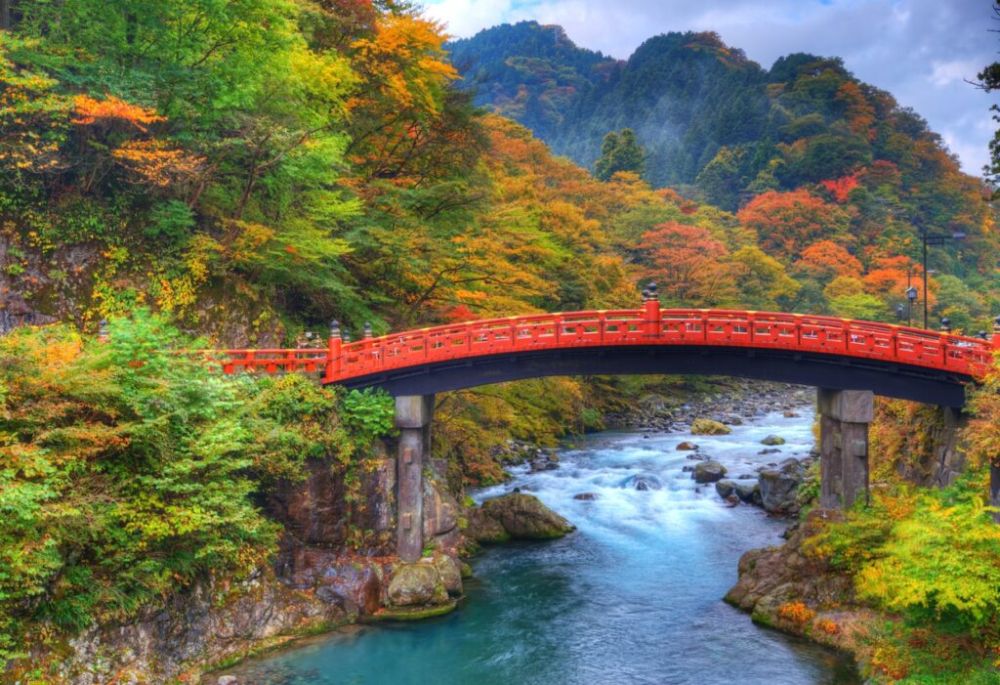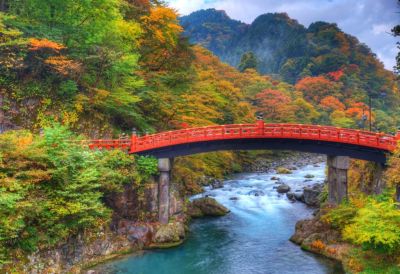

The Shinkyo Bridge, also known as the Sacred Bridge, stands majestically at the entrance to Nikko's shrines and temples and is part of the Futarasan Shrine. It's a stunning vermilion-lacquered wooden bridge that reflects beautifully on the surface of the Daiya River, especially in autumn when the leaves turn vibrant colors. Visitors come to admire its architecture and symbolic significance. According to legend, a god summoned a giant snake, which turned into a bridge for a priest to cross. As a Japan Cultural Heritage site, it's not just a bridge but a gateway to Nikko's rich history. Visitors can stroll across the bridge while enjoying views of the surrounding mountains and river, capturing the scenic vista in photos. The experience is often peaceful and inspiring, as the bridge feels like a transcendent passage through time, connecting the modern world to ancient traditions.
Just downstream of the Shinkyo Bridge, there's a delightful riverside pathway that offers a serene walking experience. Along this trail, visitors can immerse themselves in the natural beauty of Nikko, with the soothing sounds of the Daiya River, the fresh mountain air, and the picturesque scenery that includes the famed Shinkyo Bridge. This meandering path is perfect for individual reflection or a romantic stroll. While it's quite close to the town, the riverside walk has a way of making you feel deep within nature's embrace. The duration of the walk can vary as the path stretches out, enabling visitors to choose how far they want to explore. The changing seasons provide a completely different ambience throughout the year, from the lush greens of summer to the fiery backdrop of autumn, and the serene blanket of winter snow.
Start your journey into the Edo period with a guided tour of Nikko's most famous World Heritage sites, including the stunning Tosho-gu Shrine, the tranquil Rinno-ji Temple, and the stately Futarasan Shrine. As you explore these sites, you'll learn about their historical and cultural significance. The craftsmanship and detail in the architecture and carvings are a testament to the skills of Japanese artisans. These shrines and temples are not only places of worship but also monuments to the region's illustrious past. A knowledgeable guide will provide you with engaging stories and insights into Shogun Tokugawa Ieyasu's legacy, under whose order the shrines were enhanced to their current grandeur. You'll also visit Shinkyo Bridge as part of this tour, appreciating it as both an iconic landmark and a spiritual symbol of Nikko.
Nikko National Park, with Shinkyo Bridge as its gateway, offers numerous hiking trails for outdoor enthusiasts of all levels. From the leisurely paths that weave through the quieter parts of the park to the challenging ascents of Mt. Nantai, there's a trek for every kind of adventurer. These hikes provide an up-close encounter with the region's natural beauty, including waterfalls, forests, and mountain vistas. Experienced guides are available to lead you through the park's most scenic routes, ensuring you don't miss any hidden gems along the way. Besides the physical activity, hiking in Nikko National Park is a spiritual journey, with trails that pass by sacred shrines and reflect the area's deep connection to Shinto and Buddhist traditions.
Just a short distance from Shinkyo Bridge, the town of Nikko offers a vibrant local food scene that includes delicious soba noodles, yuba (tofu skin delicacies), and manju (a sweet bun with red bean filling). Food tours are available for those who wish to explore the culinary landscape guided by a local expert. Such a tour isn't just about eating; it's a cultural experience that often includes making your own soba or learning about the process of crafting yuba. Through the tastes and textures of Nikko's specialties, you will discover the intersection of food and history in this unique region. The interaction with restaurateurs and chefs, often in traditional settings, adds a layer of authenticity to the dining experience.
Whether you're an amateur photographer looking to improve your skills or a seasoned pro seeking new inspiration, Nikko presents an idyllic backdrop for photography, especially near the iconic Shinkyo Bridge. Various workshops are led by professional photographers who know the best times and spots to capture the bridge, the temples, and the scenic countryside. These workshops go beyond simply taking pictures; they delve into the artistry behind the lens, covering composition, lighting, and storytelling through imagery. The mesmerizing symmetry of Shinkyo Bridge and the surrounding natural beauty serve as perfect subjects to hone your craft. Participants leave with not just improved photographic skills, but also with a rich portfolio of stunning shots from one of Japan's most picturesque locations.
After a day of touring and sightseeing around Shinkyo Bridge and the historic sites of Nikko, a visit to one of the local hot springs (onsen) can be a heavenly retreat. The area is famous for its natural onsen, which are believed to have healing properties due to their mineral-rich waters. These tranquil baths offer a traditional Japanese relaxation experience. Many onsen facilities offer indoor and open-air baths, with views that enhance the calming experience. You can unwind, soak in the soothing waters, and let the serenity of the landscape permeate your senses. For the full experience, consider staying overnight at a ryokan (traditional inn), where you can enjoy a combination of onsen relaxation and exquisite local cuisine.
Nikko is host to a variety of seasonal festivals which provide a deeper insight into the region's traditions and celebrations. These festivals often involve processions with elaborate floats, traditional music, dance performances, and other cultural displays. One of the most famous is the Nikko Toshogu Shrine's Shunki Reitaisai held in spring, featuring the awe-inspiring Yayoi Festival. There's also the Toshogu Shrine Autumn Festival in the fall, which includes a samurai procession reflecting the pageantry of the Edo Period. The Shinkyo Bridge area becomes especially lively during these times, as the community and visitors come together to celebrate. Attending one of these festivals can be a highlight of a trip to Nikko, offering unique photo opportunities and the chance to participate in age-old customs.
The Daiya River, which flows beneath the Shinkyo Bridge, offers exciting opportunities for water-based adventures like canoeing and rafting. Visitors can join guided tours that navigate the tranquil and sometimes swiftly moving sections of the river, providing a mix of relaxation and adrenaline. Paddlers get a ground-level view of Nikko’s natural splendor, surrounded by lush forests and rugged cliffs. Instructors cater to all skill levels, ensuring a safe and enjoyable experience for everyone. The contrasting perspective of viewing Shinkyo Bridge from the river adds a unique dimension to touring Nikko. Whether you choose a gentle canoe trip or a more vigorous rafting adventure, the river connects you even more deeply with the beauty and spirit of the region.
Nikko has a rich tradition of craftsmanship, from intricate woodwork to delicate lacquerware. Various workshops within the vicinity of Shinkyo Bridge offer hands-on experiences where visitors can learn from local artisans. These workshops might involve crafting a small wood carving, creating your own piece of lacquerware, or even learning the art of Japanese calligraphy or kimono wearing. Participants gain insight into the time-honored techniques that have been passed down through generations, and they can take home a personal souvenir that they've created themselves. Engaging in these arts offers a tangible connection to Japanese culture and adds a special memory to the Nikko adventure.
